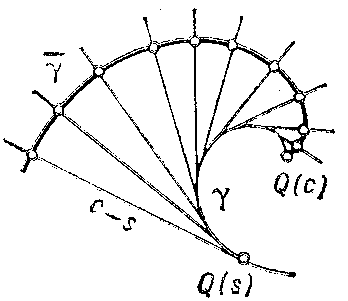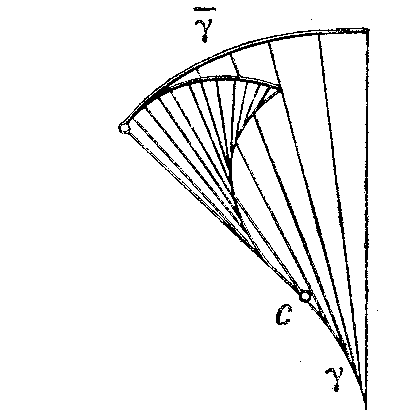Difference between revisions of "Evolvent of a plane curve"
(Importing text file) |
(TeX done) |
||
| Line 1: | Line 1: | ||
| − | + | ''involute'' | |
| − | + | A curve $\bar\gamma$ assigned to the plane curve $\gamma$ such that $\gamma$ is the [[evolute]] of $\bar\gamma$. If $\mathbf{r} = \mathbf{r}(s)$ (where $s$ is the arc length parameter of $\gamma$) is the equation of $\gamma$, then the equation of its evolvent has the form | |
| − | + | $$ | |
| − | where | + | \bar{\mathbf{r}} = \mathbf{r}(s) + (c-s)\tau(s) \,, |
| + | $$ | ||
| + | where $c$ is an arbitrary constant and $\tau$ the unit tangent vector to $\gamma$. The figures show the construction of the evolvent in two typical cases: a) if for any $s<c$ the [[curvature]] $k(s)$ of $\gamma$ does not vanish (the evolvent is a regular curve); and b) if $k(s)$ vanishes only for $s=s_1$ and $k'(s_1) \ne 0$ (the point corresponding to $s=s_1$ on the evolvent is a cusp of the second kind). | ||
<img style="border:1px solid;" src="https://www.encyclopediaofmath.org/legacyimages/common_img/e036720a.gif" /> | <img style="border:1px solid;" src="https://www.encyclopediaofmath.org/legacyimages/common_img/e036720a.gif" /> | ||
| Line 13: | Line 15: | ||
Figure: e036720b | Figure: e036720b | ||
| − | About the evolvent of a surface, see [[ | + | About the evolvent of a surface, see [[Evolute (surface)]]. |
| Line 20: | Line 22: | ||
The evolvent is often called the involute of the curve. Involvents play a part in the construction of gears. | The evolvent is often called the involute of the curve. Involvents play a part in the construction of gears. | ||
| − | For references see also [[ | + | For references see also [[Evolute]]. |
====References==== | ====References==== | ||
| − | <table><TR><TD valign="top">[a1]</TD> <TD valign="top"> K. Strubecker, "Differential geometry" , '''I''' , de Gruyter (1964)</TD></TR><TR><TD valign="top">[a2]</TD> <TD valign="top"> M. Berger, B. Gostiaux, "Differential geometry: manifolds, curves, and surfaces" , Springer (1988) pp. 305ff (Translated from French)</TD></TR><TR><TD valign="top">[a3]</TD> <TD valign="top"> J.L. Coolidge, "A treatise on algebraic plane curves" , Dover, reprint (1959) pp. 195</TD></TR><TR><TD valign="top">[a4]</TD> <TD valign="top"> H.W. Guggenheimer, "Differential geometry" , McGraw-Hill (1963) pp. 25; 60</TD></TR><TR><TD valign="top">[a5]</TD> <TD valign="top"> M. Berger, "Geometry" , '''I''' , Springer (1987) pp. 253–254</TD></TR></table> | + | <table> |
| + | <TR><TD valign="top">[a1]</TD> <TD valign="top"> K. Strubecker, "Differential geometry" , '''I''' , de Gruyter (1964)</TD></TR> | ||
| + | <TR><TD valign="top">[a2]</TD> <TD valign="top"> M. Berger, B. Gostiaux, "Differential geometry: manifolds, curves, and surfaces" , Springer (1988) pp. 305ff (Translated from French)</TD></TR> | ||
| + | <TR><TD valign="top">[a3]</TD> <TD valign="top"> J.L. Coolidge, "A treatise on algebraic plane curves" , Dover, reprint (1959) pp. 195</TD></TR> | ||
| + | <TR><TD valign="top">[a4]</TD> <TD valign="top"> H.W. Guggenheimer, "Differential geometry" , McGraw-Hill (1963) pp. 25; 60</TD></TR> | ||
| + | <TR><TD valign="top">[a5]</TD> <TD valign="top"> M. Berger, "Geometry" , '''I''' , Springer (1987) pp. 253–254</TD></TR> | ||
| + | </table> | ||
| + | |||
| + | {{TEX|done}} | ||
Revision as of 21:08, 17 December 2017
involute
A curve $\bar\gamma$ assigned to the plane curve $\gamma$ such that $\gamma$ is the evolute of $\bar\gamma$. If $\mathbf{r} = \mathbf{r}(s)$ (where $s$ is the arc length parameter of $\gamma$) is the equation of $\gamma$, then the equation of its evolvent has the form $$ \bar{\mathbf{r}} = \mathbf{r}(s) + (c-s)\tau(s) \,, $$ where $c$ is an arbitrary constant and $\tau$ the unit tangent vector to $\gamma$. The figures show the construction of the evolvent in two typical cases: a) if for any $s<c$ the curvature $k(s)$ of $\gamma$ does not vanish (the evolvent is a regular curve); and b) if $k(s)$ vanishes only for $s=s_1$ and $k'(s_1) \ne 0$ (the point corresponding to $s=s_1$ on the evolvent is a cusp of the second kind).

Figure: e036720a

Figure: e036720b
About the evolvent of a surface, see Evolute (surface).
Comments
The evolvent is often called the involute of the curve. Involvents play a part in the construction of gears.
For references see also Evolute.
References
| [a1] | K. Strubecker, "Differential geometry" , I , de Gruyter (1964) |
| [a2] | M. Berger, B. Gostiaux, "Differential geometry: manifolds, curves, and surfaces" , Springer (1988) pp. 305ff (Translated from French) |
| [a3] | J.L. Coolidge, "A treatise on algebraic plane curves" , Dover, reprint (1959) pp. 195 |
| [a4] | H.W. Guggenheimer, "Differential geometry" , McGraw-Hill (1963) pp. 25; 60 |
| [a5] | M. Berger, "Geometry" , I , Springer (1987) pp. 253–254 |
Evolvent of a plane curve. Encyclopedia of Mathematics. URL: http://encyclopediaofmath.org/index.php?title=Evolvent_of_a_plane_curve&oldid=42552